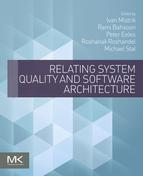Glossary
ANP The analytic network process (ANP) used in multi-criteria decision analysis. ANP structures a decision problem into a network with goals, decision criteria, and alternatives, then uses a system of pairwise comparisons to measure the weights of the components of the structure, and finally to rank the alternatives in the decision.
Architectural decision A design decision is a decision about the structure, behavior, or key properties of software system made to resolve specific problems. Architectural decisions are those decisions that impact software system’s architecture and system quality. Design decisions may be reused.
Architecture Trade-off Analysis Method (ATAM) A scenario-based software architecture evaluation methodology developed by the Software Engineering Institute (SEI).
Attribute Driven Design (ADD) A systematic step-by-step design methodology based on the architecture's quality attribute requirements.
Configurability A property of a generic system from which a concrete system can be derived.
Cynefin model A general model of decision making in a specific context.
Decision-Centric Architecture Review (DCAR) A software architecture evaluation methodology where architectural decisions are used as first class entities to uncover and evaluate architectural rationale.
Decision force Any aspect of an architectural problem arising in the system or its environment (e.g., operational, development, business, organizational, political, economic, legal, regulatory, ecological, social), to be considered when choosing among the available decision alternatives.
Decision Relationship View A graph showing the relationships between the architecture decisions elicited during a Design-Centric Architecture Review (DCAR).
Goal modeling An aspect of requirements engineering that is concerned with modeling and analysis to ensure that the proposed system meets organizational goals and to verify that the proposed system is needed and how the stakeholders’ interests may be addressed.
i* A notation for modeling and reasoning about the goals of heterogeneous actors in business and socio-technical systems. Goal graphs serve to visualize the goals of an actor.
MARTE UML profile for Modeling and Analysis of Real-Time and Embedded systems, defined by the Object Management Group. This extension of UML supports modeling of performance and real-time concepts. MARTE replaced the UML profile for Schedulability, Performance, and Time specification (SPT)
Mobile software Software systems designed and developed to run on mobile devices such as smartphones and tablets.
Multi-Objective Optimization (MOO) The process of systematically and simultaneously optimizing a collection of objective functions. MOO is used whenever certain solutions or parts of solutions exist, the values of the solutions with respect to objectives are known, and there are some constraints for selecting solutions, but the complexity of the optimization problem prevents a human from figuring out the optimum or an automated selection is desired.
Nonfunctional Requirement (NFR) A requirement that specifies criteria that can be used to judge the operation of a system, rather than specific behaviors.
Optimization Finding “best available” values of some objective function, given a defined input. There is a variety of different types of objective functions and different types of inputs.
Problem frame A means to describe and classify software development problems. Each problem frame represents a class of software problems.
Quality attribute See Nonfunctional Requirement
Quality requirement See Nonfunctional Requirement
Requirements interaction Critical relationships among a set of requirements. Requirements often interact with or influence each other. These interactions may be desirable or unwanted.
Requirements optimization The optimization process necessary to address the dynamic nature of technical and nontechnical requirements, customer needs, constraints, cost, etc.
Smart grid To use energy in an optimal way, smart grids make it possible to couple the generation, distribution, storage, and consumption of energy. Smart grids use information and communication technology, which allows for financial, informational, and electrical transactions.
Software architecture Set of principal design decisions about the system’s structure, behavior, constraints, and key properties.
Software product families See Software Product Lines
Software product lines (SPL) A set of software-intensive systems that share a common, managed set of features satisfying the specific needs of a particular market segment or mission and that are developed from a common set of core assets in a prescribed way.
Usability A measure of how easy it is to use a software system to perform prescribed tasks.
